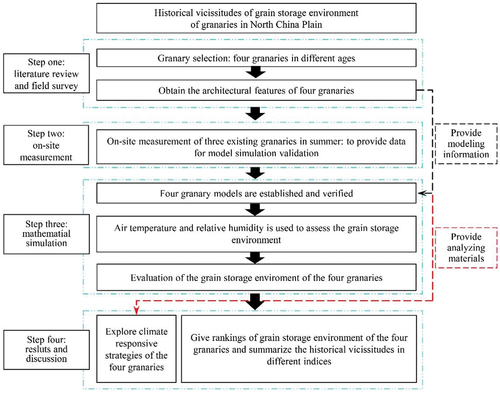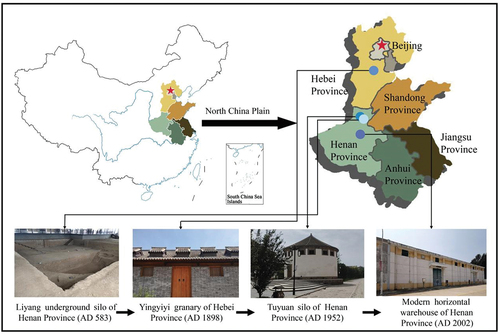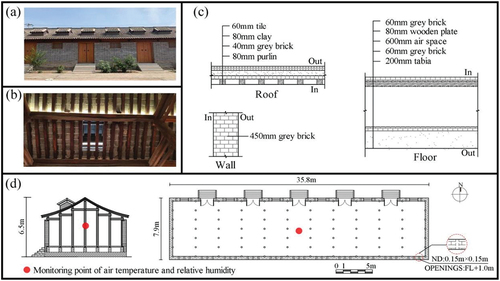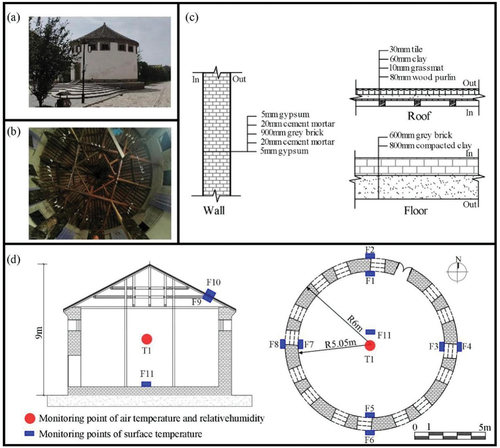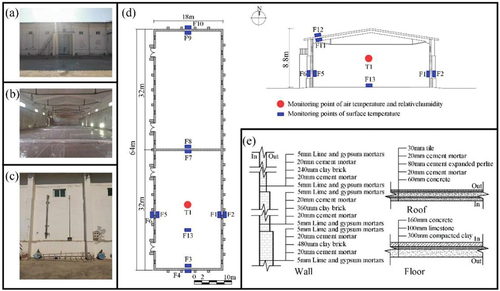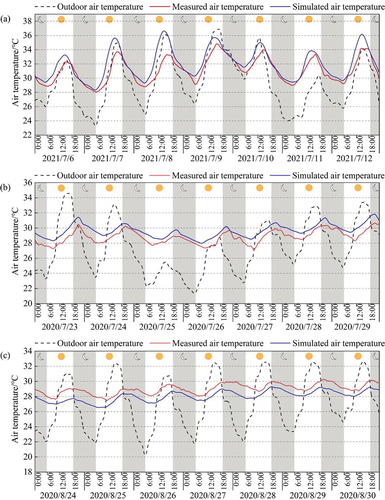 ?Mathematical formulae have been encoded as MathML and are displayed in this HTML version using MathJax in order to improve their display. Uncheck the box to turn MathJax off. This feature requires Javascript. Click on a formula to zoom.
?Mathematical formulae have been encoded as MathML and are displayed in this HTML version using MathJax in order to improve their display. Uncheck the box to turn MathJax off. This feature requires Javascript. Click on a formula to zoom.ABSTRACT
Granary evolves over time, adopting various climate responsive strategies and accordingly producing different grain storage environments. Meanwhile, as a major grain-growing area since ancient times, the North China Plain has a huge demand for granaries. Therefore, this paper investigates the historical vicissitudes of grain storage environment in North China Plain. Four granaries built during different historical periods (ranging from AD 583 to AD 2002) were selected. While their architectural features were obtained via field surveys and literature review, additional information was collected from on-site measurements to mathematically simulate the grain storage environments created by them. Results show that the grain storage environment has not been significantly improved, as the number of hours for safe grain storage has increased only by 2.36% in the past 1400 years. Further analysis revealed that these historical granaries adopted two different strategies (temperature-first vs. humidity-first) that failed to create a desirable grain storage environment, thus calling for a deliberate trade-off between air temperature and relative humidity. The present study not only deepens our understanding of historical granaries typical in the North China Plain but also provides valuable practical implications for the design and construction of modern granaries.
1. Introduction
Grain is fundamental to humans’ survival. As a result, granary is one of the architectural forms emerging early in human history. In the early stage of human history, the primary function of granaries is to secure grains against the loot of enemies and animals. With the advent of the Agricultural Civilization, grain output has increased significantly. Consequently, preserving grain quality and avoiding grain loss gradually become the main consideration of granary design. It has been widely accepted that air temperature and relative humidity inside a granary play a critical role in determining grain quality and grain loss (Chai et al. Citation2019; White, Hulasare, and Jayas Citation1999). Accordingly, in the present research, grain storage environment of granaries refers to the air temperature and relative humidity inside the granary. In order to achieve a safe grain storage environment, different climate responsive strategies (which were reflected by architectural features) have been used in various historical periods and divergent regions. It is thus likely that the actual grain storage environment may vary from time to time and from region to region. Revealing the historical vicissitudes of grain storage environment is conducive to understanding how grain storage environment can be protected by human activities.
Existing studies on granary history mainly explore how political, economic and cultural factors shapes granaries’ architectural features in various countries. For example, in Ancient China, specific forms of granaries (e.g., above-ground vs. underground) were determined by both political regimes (e.g., centralized vs. decentralized) and economic factors (e.g., the rising of canal economy) (Fei and Yu Citation2015; Han and Wang Citation0000; Ye Citation2018). In the beginning of modern China, affected by food management system of Chongqing City, the forms of granaries in Chongqing have evolved from single horizontal warehouses to conjoined vault granaries and then single Tuyuan silos (Quan and Wang Citation2021). After 1980s, a large number of granaries were updated with new materials and technologies under the support of Chinese policies (Li Citation2012; Yang, Mao, and Jiang Citation2012). Likewise, granaries in Europe have undergone similar changes. Specifically, the advanced construction technology along with economic and policy changes has made it possible to use high-strength reinforced concrete structures to build large-capacity granaries after World War II (Fernández-Fernández et al. Citation2020). However, in Africa, due to long-term economic, cultural, and technological-level constraints, most countries still use original building materials such as stone, wood panels, and adobe to build above- and below-ground granaries (Yui Citation2020). Although these studies provide valuable information for our understanding of the development of the architectural features of granaries, how these features influence grain storage environment and consequently help to protect grains awaits investigation.
In the past decade, an increasing number of research has been conducted to investigate individual granaries built in different regions and divergent historical periods, discovering different climate responsive strategies, and validating their effectiveness in creating a safe grain storage environment. For example, by measuring the air temperature and relative humidity in winter and summer inside the Fengtu charitable granary built in Qing Dynasty in China, it was found that thick and heavy envelope (i.e., wall and roof) help stabilize the air temperature inside the granary, which was conducive to grain storage safety (Yang Citation2003). The seventeenth-century Galician granary adopted a slotted construction to cope with the unfavorable environment outside the granary in autumn, winter and early spring, the effect of which has been validated by on-site measurements and simulation (Saá et al. Citation2011). Similarly, it was found that the structural form with vents can better ensure the effect of grain storage in Ancient Rome Horreum granaries, as indicated by the investigated archaeological hypotheses and corresponding simulation (Pagliaro et al. Citation2015; Saá et al. Citation2012). While these segmented studies examined different climate responsive strategies and examined their effects on the grain storage environment in different regions and ages, it remains un-investigated how grain storage environment of the granaries built in the same region but in divergent historical periods evolve over time. Consequently, a comparative approach is applied to the present research to clarify the historical vicissitudes of grain storage environments and it contributes in three aspects: 1. Our research offers a timely response to emerging calls to conduct longitudinal research in the domain of architecture and its history (Moolavi Sanzighi, Soflaei, and Shokouhian Citation2021; Ozay Citation2005). Specifically, the present research, to the best of our knowledge, is the first research that comparatively examined and analyzed the dynamics of grain storage environments of granaries in a given region. Importantly, by comparing four granaries from different historical periods, our research aims to reveal the different strategies used to creating desirable grain storage environment. 2. By conducting a longitudinal comparison, the climate responsive strategies of each of the four grain storage environment of four historical granaries are identified. Accordingly, the adequacy and diversity of passive design strategies of granaries are ensured. 3. Therefore, the present research provides more lessons for the design of modern grain storage environment.
Particularly, the vicissitudes of granaries built in the North China Plain has not been reviewed and studied. Throughout the history of China, the North China Plain is a primary production area of various grains. It covers about 300,000 km2, features a temperate continental climate, and is located in latitude 32°N ~ 40°N, longitude 114°E ~ 121°E. The suitable climate, fertile soil, sufficient water source and convenient transportation jointly make the North China Plain an important grain growing area since ancient times. In modern China, 80% of wheat production (about 108 million tons per year) originates from this area. Accordingly, the demand for granaries has usually been emphasized, and throughout the history, a large number of granaries with different architectural features have been built in this area. More importantly, many of the granaries built in the North China Plain are well preserved. Therefore, the diversity and accessibility of granaries in the North China plain make it theoretically necessary and technically feasible to conduct a comparative analysis of different granaries in this area.
To fill this gap, the present research briefly reviewed different types of granaries in the North China Plain, which is built in different historical periods, and consequently selected four typical granaries as research objects. Their architectural features are summarized by both literature review and field survey. Four simulation models were established to assess grain storage environment inside them in summer and transition seasons. Hence, the present research offers, to the best of knowledge, the first endeavor to apply a longitudinal approach and comparatively study the historical vicissitudes of grain storage environment of granaries in the North China Plain. Surprisingly, the present research found that even though the grain storage environment of historical granaries indeed improves over time, the improvement is highly limited. Noticeably, even the most recent modern horizontal warehouse, without active ventilating and cooling, failed to create sufficient hours for a safe grain storage environment. The present research therefore suggests the huge room for future granary research to optimize climate responsive strategies and generate enhanced storage environments. The present research thus helps to reveal the development pattern of grain storage environment in North China Plain and enrich the research connotation of granary’s architecture history. Besides, it also summarizes the grain storage environment creation techniques (i.e., climate responsive strategies) of historical granaries in the North China Plain, accordingly providing a repertoire to develop modern granaries in China.
The remainder of the paper is structured as follows. We first present the methodology parts which covers literature review, field survey, on-site measurement and mathematical simulation. We then analyzed the historical vicissitudes of the four granaries’ grain storage environment created by climate responsive strategies. At last, the article ends with a discussion and conclusion.
2. Methodology
As illustrated by , the research methods in the present research include literature review, field survey, on-site measurement and mathematical simulation. In step one, a brief literature review was conducted to select four granaries in North China Plain built in different historical periods. The architectural features of selected granaries and relevant parameters for simulation were subsequently obtained via field surveys. However, relevant information of Liyang underground silo, the oldest granary selected, is obtained exclusively from literature review, as only traces are left. In step two, on-site measurement was carried out for three existing granaries. In step three, four granary models were created, using data mainly obtained in step one and utilizing EnergyPlus software. Then, three existing granary models were validated with the on-site measurement data obtained from step two. The grain storage environment (i.e., air temperature and relative humidity) in summer and transition seasons were thus simulated. In step four, the four granaries’ climate responsive strategies and their grain storage environment were analyzed and compared, based on which the historical vicissitudes of the four granaries’ grain storage environment were summarized.
2.1. Granary selection
Since the Neolithic period, both above-ground and underground granaries have been in existence in China. For example, archaeological excavation has found several granaries in several historical relics including the traces of Yanshi Shang city (above-ground granary) (Chen Citation2020), the traces of Cishan (underground granary) (Sun, Liu, and Chen Citation1981), and the traces of Eastern Zhou capital (underground granary) (Yunzhang and Mengke Citation2021a, Citation2021b). However, the constructing technology of granaries in the early stage of China’s history was relatively primitive. Importantly, the granaries built in early history of China are not preserved well due to the long history, and at the same time, there is little written record about their architectural features, making it technically difficult to investigate these granaries. By the contrast, a large number of underground granaries built in Sui and Tang Dynasties (AD 581–907) (e.g., Hanjia underground silos, Luokou underground silos, and Liyang underground silos) have received considerable written records. Noticeably, the architectural features of Liyang underground silos and Hanjia underground silos have been investigated. Several architectural models have been proposed to detail their architectural features (Zhang Citation2017), making them suitable for the present research. However, Hanjia underground silos were completely closed to the public due to strict protection when the present research was conducted. Therefore, Liyang underground silo is selected for the present research as the representative of the underground granary in this period. During the Song and Yuan Dynasties (AD 960–1368), the underground silos gradually declined but did not disappear completely. Meanwhile, the large state-owned granaries were mainly built above the ground, most of which have not been well preserved due to the influence of war and natural weathering. Thus, granaries in this period were not selected for the present research. During Ming and Qing Dynasties (AD 1368–1912), above-ground granaries received continuous development. Besides, thanks to the closer history, some historical granaries built in this period have been well preserved (e.g., Nanxin granary and Yingyi charitable granary). Nevertheless, Nanxin granary has been transformed into a leisure and cultural exhibition hall while the original appearance of Yingyi charitable granary has been maintained as much as possible (Liu and Xue Citation2003; Sun, Li, and Tang Citation2014). Therefore, Yingyi charitable granary is selected as the representative of the above-ground granary in this period for the present research. Shortly after the founding of People’s Republic of China (AD 1949), Tuyuan silos became the primary form of granaries with many of them well preserved in various regions of China, including the North China Plain. This type of granary is thus chosen as the representative of the granary built in the early stage of industrialization. In modern China, granaries have taken diverse forms, with the advance of science and technology, including silo, squat silo and horizontal warehouse. Despite the design diversity of modern granaries, the majority takes a horizontal form (Wang Citation2007). Therefore, Modern horizontal warehouse is selected for the present research as the representative of modern granaries. To sum up, Liyang underground silo, Yingyi charitable granary, Tuyuan silo and Modern horizontal warehouse are selected as four research objects of the present research. The build time, geographical locations, and climate conditions of the four selected granaries are listed in and .
Table 1. Basic information of the four selected granaries.
2.2. Field survey
Field survey aims to obtain architectural features of the selected granaries, which serves as the basis for qualitatively analyzing climate responsive strategies and provides parameters for establishing granary models in section 2.4.1.
2.2.1. Liyang underground silo (AD 583)
Liyang underground silos built in Sui Dynasty (AD 583) are architectural complex. Because of the distant long history, only several traces have been discovered. Therefore, in-depth field survey and on-site measurement are not possible. However, adopting archaeological methods, previous researchers have successfully investigated one of the traces and consequently build an architectural model for Liyang underground silo (Zhang Citation2017). Therefore, the architectural features are obtained from previous research (Zhang Citation2017). As shown in , Liyang underground silo consists of an upper part and a lower part. The upper envelop consists of a 500 mm-thick clay wall and a 780 mm-thick roof. The upper part serves to locate the silo, shield it from wind and rain, isolate the air temperature outside the silo and reduce the influence of solar radiation on the storage space (which can be considered as buffer space). By the contrast, the lower part is a rounded-cone-shaped storage space with an upper radius of 6 m, a lower radius of 3.5 m and a depth of 3.2 m. Since the upper envelope and the grain cover are built with clay and sand, the silo creates excellent air tightness. The silo’s architectural features are illustrated in . Considering the space limitation of this paper, its construction and thermal parameters are shown in the appendix ().
Figure 3. Architectural features of Liyang underground silo: (a) Picture of traces; (b) Schematic diagram of investigated archaeological hypotheses (Zhang Citation2017); (c) Layout plan and section plan (Zhang Citation2017), and (d) Construction of envelope (Zhang Citation2017).
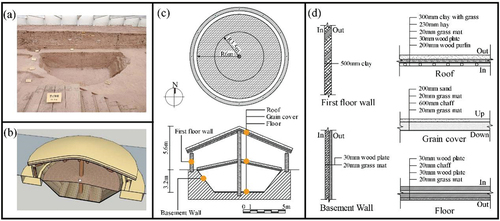
2.2.2. Yingyi charitable granary (AD1898)
Yingyi charitable granary is in the form of a courtyard, with four individual granaries located in the east, west, north, and south. Each individual granary adopts similar architectural features. Due to wars and their long history, the east granary has been completely destroyed, while the west granary and the north granary have been partially destroyed. Therefore, the south granary was selected for the present research. According to the field survey, the selected granary is 35.8 m long and 7.9 m wide. The granary has a brick-wood structure. The exterior wall of the granary is made of 450 mm-thick grey brick and the roof is a traditional sloping roof. Additionally, there is a 600 mm-high air layer between the grain storage space and the ground. For better ventilation, 33 openings are designed on the foot of its south and north walls, respectively. Besides, 11 dormer windows are non-closable and they are installed on its roof for ventilation. The granary’s architectural features are illustrated in . Considering the space limitation of this paper, its construction and thermal parameters are shown in the appendix ().
2.2.3. Tuyuan silo (AD1952)
Tuyuan silo is a brick silo, with its door opened outwards in the northeast. The height from the ground to the bottom of the eave is 5.5 m, and the height from the bottom of the eave to the roof is 3.5 m. There are 15 windows and a small door on the wall at 4.5 m above the ground. Among them, a small door (1 m × 1.5 m) is in the northeast, and the rest are windows (1 m × 0.8 m). The granary employed a brick-wood structure and was built with a 950 mm-thick wall and a pyramidal roof. The top of the silo is a wooden beam construction. The silo’s architectural features are illustrated in . Considering the space limitation of this paper, its construction and thermal parameters are shown in the appendix ().
2.2.4. Modern horizontal warehouse (AD 2002)
As shown in , the modern horizontal warehouse consists of two single granaries. Each granary is 32 m long and 18 m wide. Each individual granary adopts similar architectural features. However, the north granary does not have a south-facing surface (i.e., direct solar gain surface), which cannot reflect the actual heat transfer process of most granaries. Therefore, the south granary was selected for the present research. Taking the south warehouse for example, there are eight small windows (1 m × 0.75 m) on the east exterior wall and six small windows on the west exterior wall (1 m × 0.75 m). As shown in , there are two small doors (0.67 m × 1.25 m), for stuff to get into the granary on the west exterior wall, above the grain loading gate (2.35 m × 4.25 m). To control the mechanical properties and the building cost, the thickness of their walls decreases from bottom to top (An Citation2015; Zhang and Lan Citation1997). That is, clay bricks with different thicknesses of 240 mm, 360 mm, and 480 mm are used to build the exterior wall from top to bottom. Reinforced concrete fold-line warehouse roof is adopted for the granary. It should be noticed that the modern horizontal warehouse also witnessed the involvement of building materials while inheriting the building materials of ancient granaries. Therefore, the construction of modern granaries also uses modern materials such as concrete, cement expanded perlite, rigid plastics polyurethane foam, etc. The granary’s architectural features are illustrated in . Considering the space limitation of this paper, its construction and thermal parameters are shown in the appendix ().
2.3. On-site measurement
The purpose of on-site measurement is to collect data for the validation process for simulation models in section 2.4.2. The measured items are shown in . It should be noted that as previously mentioned, Liyang underground silo cannot be on-site measured given that only its trace has been left. Therefore, on-site measurement was conducted for Yingyi charitable granary, Tuyuan silo and Modern horizontal warehouse.
Table 2. On-site measurement items and measurement period.
As the present research aims to compare the actual grain storage environment created by the four granaries, the treatment of granary windows and doors and the granary operating conditions during the measurement period is in line with the actual ventilating/operating practice of each granary. Accordingly, during the measurement period, the ventilation systems (e.g., windows) and operating conditions (e.g., indoor heat source, human behavior, air conditioning system) are set according to historical practice. Regarding the ventilation system, in history, the holes and dormers of Yingyi charitable granary are assumed to be open all the time (information obtained from its architectural features). As a result, during the on-site measurement, all the holes and dormers (which are different with regular windows) were kept open. Similarly, given that the windows and doors of Tuyuan silo and Modern horizontal warehouse are assumed to be closed during the summer and transition seasons (Bai et al. Citation2006; Bai, Bian, and Wang Citation2004; Song, Jin, and Wang Citation2009), the windows were closed during on-site measurement. Regarding the operating conditions, in history, when granaries were empty, all granaries were free-running buildings, with no internal heat sources, no occupants, and no air conditioning systems (information obtained from their architectural functions and the site managers during field survey). Therefore, during the on-site measurement, three granaries had the same operating conditions: empty and free-running, no internal heat sources, no occupants, and no air conditioning systems.
The instruments employed for the measurement followed ISO Standard 7726 (ISO7726 Citation2002). The specific models of the measurement instruments are shown in the appendix (). All instruments were calibrated in accordance with corresponding instructions. Data loggers record automatically every 10 min, except CO2 concentration recorder. The decay method with CO2 as the tracer gas has been proved to be an effective infiltration rate (and ventilation rate) measurement method (Benedettelli, Naticchia, and Carbonari Citation2015; Persily Citation2016; Van Hooff and Blocken Citation2013). The specific measurement points inside each granary are shown in for Yingyi charitable granary, Tuyuan silo and Morden horizontal warehouse, respectively. Noticeably, the surface temperature inside and outside the Yingyi charitable granary was not measured. Because the instrument cannot be placed on its wall, given that it is a National Cultural Heritage Site under strict protection.
2.4. Simulation
Although a short-term on-site measurement to a degree can reflect the grain storage environment inside a granary, a simulation for a longer period of time is required to form a more accurate evaluation. Therefore, the EnergyPlus software was used to build simulation models for the four selected granaries.
Both relevant literature and real-world practice have demonstrated that the cold and dry climate in North China Plain in winter lends itself to the effortless creation of a desirable grain storage environment (Bai et al. Citation2006; Bai, Bian, and Wang Citation2004). By the contrast, under the combined effect of high humidity and high temperature outside the granary in summer, it is more difficult to maintain an ideal environment for grain storage (Bai et al. Citation2006; Bai, Bian, and Wang Citation2004; Zhang et al. Citation2014). Thus, it is important to examine how grain storage environment can be created by the four selected granaries with diverse architectural features in summer. In addition, the large fluctuation of outdoor temperature and relative humidity during the transition seasons also makes it relevant to investigate the grain storage environment of the four granaries during the transition seasons (Bai et al. Citation2006; Duan and Zhang Citation1984; Peng and Deng Citation2019). Therefore, the present research simulates the grain storage environment during summer and transition seasons (March to November, 6600 hours in total).
The grain storage environment of the four selected granaries was then evaluated according to the number of hours in the simulated period that meet different criteria. The simulation process is shown in .
2.4.1. Model description
EnergyPlus software was used to model the four selected granaries. The mathematical model of a building generally consists of three main components: 1. the basic information of a building (e.g., location, geometric information, etc.); 2. Building operating conditions (e.g., indoor heat sources, air conditioning system, etc.); 3. Calculation parameters (e.g., outdoor climate data and calculation period). lists all the parameters used to build granary models and their sources.
Table 3. Input parameters and their sources of four mathematical models for grain storage environment simulation.
It should be noticed that the simulation of grain storage environment is conducted with only climate responsive design considered (i.e., without active cooling/ventilating). Because the research objects are mainly ancient granaries, active ventilation and cooling are not available when these granaries were built.
As mentioned earlier, during the measurement period, for the three on-site measured granaries, there was no internal heat source, no occupants and no air conditioning system applied to them, which reflected the actual operating practice of each granary. As a result, the value of the relevant parameters used for simulation is zero. Regarding Liyang underground silo, according to the information obtained from its architectural features and literate review (Zhang Citation2017), the relevant parameters value is also zero. Similarly, the infiltration rate of Liyang underground silo is assumed to be zero due to its excellent air tightness.
Outdoor climate data is necessary for a building simulation study. In the present research, the modern meteorological data is used: A special meteorological data set for building thermal environment analysis in China (China Meteorological Administration Citation2005). Although the meteorological parameters have changed in the past thousands of years, the temperature fluctuation in China is relatively small (only 1 ~ 2°C) (Jiang et al. Citation2015; Zhu Citation1972). Therefore, in this study, the TMY data were used to create simulations for the four selected granaries. In addition, since the operation of granaries requires a large site for field operations, granaries are generally built in open areas. Accordingly, the shading of surrounding buildings is not considered in this present research. The granary models are shown in .
2.4.2. Validation criteria
It is necessary to valid the established granary model before the actual simulation study. In the present research, two indices widely accepted by the architecture research are used: Normalized Mean Bias Error (NMBE) and Coefficient of Variation of Root Square Mean Bias Error CV (RMSE) (ASHRAE Citation2002). The items to validate granary models are measured by air temperature inside a granary and simulated air temperature inside a granary. The basic information of models and their sources are the same as , while the rest input parameters used for model validation and their sources are shown in .
Table 4. Additional input parameters and their sources of three mathematical models for validation.
The validation is conducted for Yingyi charitable granary, Tuyuan silo and Modern horizontal warehouse. Noticeably, the model of Liyang underground silo cannot be validated. As previously pointed out, data required to validate the model cannot be obtained from on-site measurement. Instead, the model is directly created by using parameters offered by previous research (Zhang Citation2017). It should be noticed that when only traces are available, creating simulation model for historical granary without validation through measurement is an imperfect but acceptable practice in granary thermal environment modeling (Pagliaro et al. Citation2016).
NMBE and CV (RMSE) are calculated by EquationEquation (1)(1)
(1) and EquationEquation (2)
(2)
(2) , respectively.
Where tip is the simulated air temperature of the node, tim is the test air temperature of the node tm, is the arithmetic mean of the sample of n measured data, and n is the number of data during the test obtained from our on-site measurement.
2.4.3. Evaluation criteria
Previous studies show that the deterioration of grain quality is determined by complex factors such as mold growth, pest invasion, and the reduction of nutritional quality (Sánchez-Ramos, Álvarez-Alfageme, and Castañera Citation2007; Zhang et al. Citation2017). The occurrence of these factors depends on the temperature and moisture of the stored grain itself and the air temperature and relative humidity of the storage environment (Silva et al. Citation2021; White, Hulasare, and Jayas Citation1999; Zhang et al. Citation2017). Noticeably, when the storage environment temperature is between 25°C and 35°C and the relative humidity is higher than 70%, insects and molds will dramatically grow. Furthermore, long-term high temperature (i.e., >30°C) also speeds up the denaturation of proteins, decreasing grain’s appearance and nutritional quality. Although some studies suggest that when the environment temperature is 40°C, the growth of pests and fungi will be slowed down, more studies reveal that low air temperature and low relative humidity environment are more conducive to ensuring the safety of food storage (Chai et al. Citation2019; Kaleta and Górnicki Citation2012; Sánchez-Ramos, Álvarez-Alfageme, and Castañera Citation2007). In line with relevant literature and following the national norms (Bai et al. Citation2006; GB/T 29890-2013 Citation2013; Hammami, Ben Mabrouk, and Mami Citation2017), air temperature (i.e., air temperature criterion: <20°C), relatively humidity (i.e., relative humidity criterion: <70%) and the combination of the two are selected (i.e., comprehensive criterion: <20°C and <70%) as the criteria to evaluate grain storage environment.
3. Results
3.1. Climate responsive strategies of the four granaries
According to the literature review and field survey, the four typical granaries studied in the present research adopt different climate responsive strategies, even though they are all geologically located in North China Plain. shows the climate responsive strategies of the four granaries.
Liyang underground silo which was built in the Sui Dynasty (AD 583) was an underground granary. The building materials are simple and primary, mainly including soil, wood, sand, etc. The architectural features reflecting the climate responsive strategy include the underground space, the thick and heavy envelope (i.e., 500 mm-thick clay wall, 780 mm-thick roof), the grain cover, the upper space (buffer space) and the sealed space (excellent air tightness). Specifically, underground space is conductive to a low air temperature inside the silo by using the low temperature beneath the ground. Thick and heavy envelope, grain cover and upper space can help the silo to resist random changes of outdoor air temperature and solar radiation by using building construction’ thermal resistance and thermal inertia.
Yingyi charitable granary built in Qing Dynasty (AD1898) is an above-ground granary. Apart from wood, its building materials mainly include grey brick, clay, etc. The architectural features reflecting its climate responsive strategy include thick and heavy envelope (i.e., 450 mm-thick grey brick wall), the air space layer (i.e., 600 mm-high air layer between the grain storage space and the ground), the openings in the lower part of the wall and the dormer windows. As in the case of Liyang underground silo, thick and heavy envelope can help the granary to deal with random changes of outdoor air temperature and solar radiation by utilizing building envelope’s thermal resistance and thermal inertia. The air space layer can avoid the direct connection between damp ground and loaded grains. The openings in the lower part of the wall and the dormer windows can further control grain storage environment (relative humidity) by introducing outdoor air via natural ventilation. Since Yingyi charitable granary, the design of ventilation and infiltration has been introduced into the creation of grain storage environment. However, limited by their construction, the openings and dormer windows have been kept open all the time, avoiding a humid environment. But in this case, it is difficult to control temperature.
Following the Yingyi charitable granary, Tuyuan silo was built shortly after People’s Republic of China was established (AD1952) and it is an above-ground granary. The building materials mainly include gray brick and clay, etc. The architectural features reflecting the climate responsive strategy include thick and heavy envelope (i.e., 950 mm-thick grey brick wall, 1400 mm-thick floor), 15 windows and a small door on the top of wall. Like Yingyi charitable granary, building envelope’s thermal resistance and thermal inertia are exploited to create desirable air temperature. Moreover, the 15 windows and a small door allow the natural ventilation of the granary. Unlike the Yingyi charitable granary, these windows are switchable, making it possible to control both temperature and humidity.
Modern horizontal warehouse is also an above-ground granary, it was built in 2002. The building materials mainly include brick, concrete, etc. The architectural features reflecting its climate responsive strategy include thick and heavy envelope (i.e., 290/410/530 mm-thick brick wall), 14 windows and 2 small doors on the top of wall, and new types of thermal insulation materials (i.e., cement expanded perlite and rigid plastics polyurethane foam). In addition to the common architectural features of Yingyi charitable granary and Tuyuan silo, the application of new materials further increased the thermal resistance of roof and the front door. In addition, inherited from Tuyuan silo, windows can be either closed or opened, making it possible to control both humidity and temperature during the silo’s operation.
3.2. On-site measurement results
Due to limited space, only results related to grain storage environment and outdoor climate data (i.e., air temperature and relative humidity inside/outside a granary, solar radiation) and infiltration/ventilation rate rates are reported here.
shows the indoor and outdoor air temperature, indoor and outdoor relative humidity, and solar radiation for the three granaries during the measurement period. Regarding Yingyi charitable granary, during the measurement period, the indoor and outdoor average temperatures was 31.1°C and 29.4°C, respectively; the maximum outdoor air temperature difference was 13°C, nevertheless, the maximum indoor air temperature difference was 6.6°C. The indoor and outdoor average relative humidity was 59.1% and 69.1%, respectively. The maximum outdoor solar radiation is 898.9W/m2 and the average value is 357.0W/m2 during the daytime. As for Tuyuan silo, during the measurement period, the indoor and outdoor average temperatures was 29.3°C and 27.3°C, respectively; the maximum outdoor air temperature difference was 13.3°C, nevertheless, the maximum indoor air temperature difference was 3.7°C. The indoor and outdoor average relative humidity was 63.9% and 71.9%, respectively. The maximum outdoor solar radiation is 956.8W/m2 and the average value is 449.2W/m2 during the daytime. As to Modern horizontal warehouse, during the measurement period, the indoor and outdoor average temperatures was 28.5°C and 26.9°C, respectively; the maximum outdoor air temperature difference was 12.5°C, nevertheless, the maximum indoor air temperature difference was 2.8°C. The indoor and outdoor average relative humidity was 68.8% and 74.7%, respectively. The maximum outdoor solar radiation is 904.6W/m2 and the average value is 447.4W/m2 during the daytime.
Figure 10. The measurement results of (a) Yingyi charitable granary; (b) Tuyuan silo and (c) Modern horizontal warehouse.
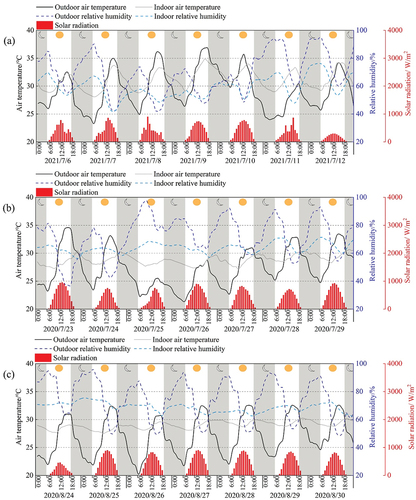
The measured results of infiltration/ventilation rates are listed as follows: 2, 0.3 and 0.1 times/h, for Yingyi charitable granary, Tuyuan silo and Modern horizontal warehouse, respectively.
3.3. Validation results
The validation results are shown in . The NMBE and CV(RMSE) values of Yingyi charitable granary are 2.79% and 4.12%, respectively. The corresponding values of Tuyuan silo are 2.80% and 3.06%, respectively. And the corresponding values of Modern horizontal warehouse are −3.26% and 3.42%, respectively. The validation proves the reliability of software and the validity of models which will be used in the following simulation study.
3.4. Simulation results
After obtaining the simulation results of the 6600-hour temperature and relative humidity, we used heat map and box plot to visualize the simulation results. The heat map shows the hourly distribution of temperature and relative humidity in the granaries. The box plot shows the monthly volatility of temperature and relative humidity.
3.4.1. Simulation results of Liyang underground silo (AD 583)
shows the simulation results of hourly indoor air temperature in the summer and transition seasons of Liyang underground silo. The indoor air temperature is lower than 20°C for 5858 hours, accounting for 88.8% of the total simulated hours. shows the box plot of monthly air temperature range. As figure shows, the indoor air temperature inside the silo is almost below 20°C in all simulated hours. The lowest monthly average temperature reaches 3.6°C, which occurred in March. The highest monthly average temperature occurs in August with a temperature of 20.5°C. The simulation results indicate that the climate responsive strategies of Liyang underground silo (i.e., the underground space, the thick and heavy envelope, the grain cover, the buffer space and the excellent air tightness) can withstand the high outdoor temperature environment effectively.
Figure 11. Simulation results of Liyang underground silo in the summer and transition seasons: (a) hourly indoor air temperature; (b) monthly indoor air temperature range; (c) hourly indoor relative humidity; (d) monthly indoor relative humidity range.
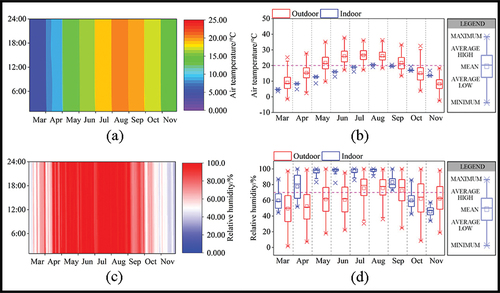
shows the simulation results of hourly relative humidity. Relative humidity in Liyang underground silo is below 70% for 2356 h, accounting for 35.7% of the total simulated hours. shows the box plot of monthly relative humidity. As figure shows, the relative humidity is always above 70% from May to September. All the simulated hours in November have relative humidity below 70%. More than 80% of the simulation hours in March and October has the relative humidity below 70%. In April, 40% of the simulation hours have the relative humidity below 70%. The lowest monthly average relative humidity is 45.8%, which occurs in November, and the highest 98%, which occurs in August.
The results show that the relative humidity in Liyang underground silo is high throughout the entire simulated period. In particular, in summer the relative humidity can be as high as 90%. The characteristics of high relative humidity in the underground space have been presented in previous studies (Galgaro et al. Citation2020; Mazarrón et al. Citation2013).
3.4.2. Simulation results of Yingyi charitable granary (AD1898)
shows the simulation results of hourly indoor air temperature in the summer and transition seasons of Yingyi charitable granary. The indoor air temperature is lower than 20°C for 2518 h, accounting for 42.6% of the total simulated hours. shows box plot of monthly air temperature range. As the figures show, all the simulated hours in March and November are below 20°C. More than 70% simulated hours in April and October have the indoor air temperature below 20°C. As of May and September, only about 10% of the simulated hours have the indoor air temperature below 20°C. June, July and August (summer season) have 100% of the simulated hours with temperature higher than 20°C. The lowest monthly average temperature is 7.0°C, which occurs in November, and the highest monthly average temperature is 28.9°C, which occurs in July. Generally, Yingyi charitable granary fails to address the high temperature in summer season. The non-closable ventilation construction makes the air temperature inside granary subject to the outdoor temperature.
Figure 12. Simulation results of Yingyi charitable granary in the summer and transition seasons: (a) hourly indoor air temperature; (b) monthly indoor air temperature range; (c) hourly indoor relative humidity; (d) monthly indoor relative humidity range.
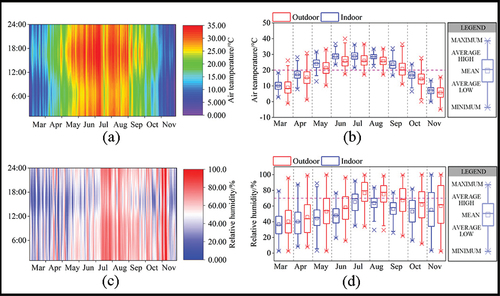
shows the simulation results of hourly relative humidity. Relative humidity in Yingyi charitable granary is below 70% for 5548 h, accounting for 84.1% of the total simulated hours. shows the box plot of monthly relative humidity. Overall, the granary has good performance on humility control. Among all the simulation months, more than 80% of the simulated hours in March, April, May, June and September have the relative humidity below 70%. July, August and November have slightly weaker control over relative humidity. The lowest monthly average relative humidity is 36.4%, which occurs in March, and the highest monthly average relative humidity is 65.2%, which occurs in July. The simulation results show that although the monthly fluctuation in relative humidity is large, the overall humidity control is acceptable. The non-closable ventilation construction can help control relative humidity inside the granary by introducing outdoor air.
3.4.3. Simulation results of Tuyuan silo (AD1952)
shows the simulation results of hourly indoor air temperature in the summer and transition seasons of Tuyuan silo, the indoor air temperature is lower than 20°C for 2434 h, accounting for 36.9% of the total simulated hours. shows box plot of monthly air temperature range. As figure shows, all the simulated hours in March and November are below 20°C. More than 80% and 50% simulated hours in April and October have the indoor air temperature below 20°C, respectively. From May to September, all the simulated hours have the indoor air temperature above 20°C. The lowest monthly average temperature reaches 12.4°C, which occurs in March. The highest monthly average temperature occurs in July with a temperature of 30.2°C. The simulation results clearly show the adjustment of outdoor temperature fluctuation by the climate responsive strategies of Tuyuan silo (i.e., the thick and heavy envelope). However, there are still considerable simulated hours with high temperature, indicating that the thermal insulation design needs to be strengthened.
Figure 13. Simulation results of Tuyuan silo in the summer and transition seasons: (a) hourly indoor air temperature; (b) monthly indoor air temperature range; (c) hourly indoor relative humidity; (d) monthly indoor relative humidity range.
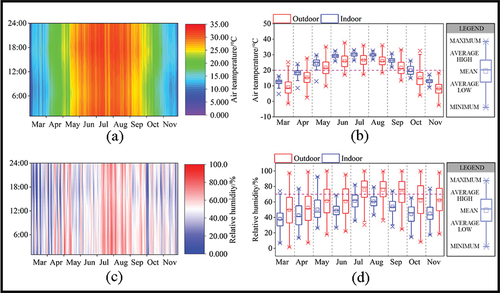
shows the relative humidity heat map. Relative humidity in Tuyuan silo is below 70% for 6220 h, accounting for 94.2% of the total simulated hours. shows the box plot of monthly relative humidity. As the figure shows, except for July, the other months have more than 90% of the simulation hours with relative humidity below 70%. The lowest monthly average relative humidity is 37.9%, which occurs in March, and the highest monthly average relative humidity is 65.2%, which occurs in July. The results show that Tuyuan silo has great relative humidity performance, which basically meets the humidity requirement of safe grain storage.
3.4.4. Simulation results of modern horizontal warehouse (AD2002)
shows the simulation results of hourly indoor air temperature in the summer and transition seasons of Modern horizontal warehouse. The indoor air temperature is lower than 20°C for 2726 h, accounting for 41.3% of the total simulated hours. shows the box plot of monthly air temperature range. As figure shows, the indoor air temperature of all the simulated hours from May to August is above 20°C. All the simulated hours in March and November are below 20°C. More than 80% simulated hours in April and October have the indoor air temperature below 20°C. In September, only about 6% of the simulated hours have indoor air temperature below 20°C. The lowest monthly average temperature reaches 11.8°C, which occurs in November. The highest monthly average temperature occurs in July with a temperature of 29.3°C. The simulation results show that, despite the climate responsive strategies are applied in Modern horizontal warehouse (i.e., thick and heavy envelope, new types of thermal insulation materials, windows and doors), the indoor air temperature cannot be satisfied. In particular compared to Liyang underground silo, the granary build 1400 year ago, the number of hours meeting the safe temperature requirements is reduced by 3132 h. A more scientific design for the grain storage environment of modern granary is necessary.
Figure 14. Simulation results of Modern horizontal warehouse in the summer and transition seasons: (a) hourly indoor air temperature; (b) monthly indoor air temperature range; (c) hourly indoor relative humidity; (d) monthly indoor relative humidity range.
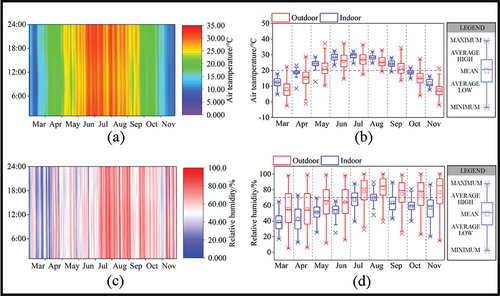
shows the simulation results of hourly relative humidity. Relative humidity in Modern horizontal warehouse is below 70% for 5468 h, accounting for 82.8% of the total simulated hours. shows the box plot of monthly relative humidity. As the figure shows, relative humidity is always below 70% in March, May and June; More than 95% of the simulation hours in April and October have the relative humidity below 70%. More than 70% of the simulation hours in September and November have the relative humidity below 70%. In July and August, 49.7% and 51.1% of the simulation hours have the relative humidity below 70%, respectively. The lowest monthly average relative humidity is 38.9%, which occurs in March, and the highest monthly average relative humidity is 69.8%, which occurs in August. Overall, the relative humidity performance of the warehouse is excellent.
4. Discussion
The discussion has three parts. Firstly, it briefly discusses the methodological contribution of the present study. Secondly, a comparative analysis of grain storage environment of four granaries based on the simulation results is presented to articulate their historical vicissitudes. Thirdly, the lessons for designing modern granaries and improving their grain storage environment is presented.
4.1. Methodology contribution
The present research combines a longitudinal perspective and quantitative modeling to investigate the vicissitudes of four historical granaries. Specifically, consistent with the emerging study (Moolavi Sanzighi, Soflaei, and Shokouhian Citation2021), the present research selected four historical granaries built in different periods in the North China Plain, mathematically simulated, and subsequently compared their performance in creating grain storage environment. This longitudinal-quantitative approach allows several unique advantages. First, multiple historical granaries are selected, analyzed, and compared using identical criteria and similar procedures. Compared to studies separately exploring different historical granaries (Saá et al. Citation2011, Citation2012), the longitudinal-quantitative approach ensures the comparability of the analysis of different historical granaries, contributing to the internal validity. Second, unlike qualitative methods, mathematical modeling and simulation make it possible to integrate a wide range of factors (e.g., diverse climate responsive design methods) and their interactions into consideration. Thus, the complex effect of different climate responsive strategies is summarized and quantified as several simple indexes (temperature criterion, humidity criterion, and comprehensive criterion), making longitudinal comparisons more intuitive. Accordingly, the longitudinal-quantitative approach offers future research a valid and easy-to-understand way to examine the dynamism of historical granaries and explore the vicissitudes of grain storage environment created by them.
4.2. Grain storage environment vicissitudes of four granaries
Based on the simulation results, the grain storage environment of the four selected granaries is compared and ranked, which characterizes the vicissitudes of grain storage environment of them. shows the comparison of grain storage environment, in terms of the three criteria.
In terms of temperature criterion, Liyang underground silo 5858 h > Yingyi charitable granary 2815 h > Modern horizontal warehouse 2726 h > Tuyuan silo 2434 h;
In terms of humidity criterion: Tuyuan silo 6220 h > Yingyi charitable granary 5548 h > Modern horizontal warehouse 5468 h > Liyang underground silo 2356 h;
In terms of comprehensive criterion: Modern horizontal warehouse 2512 h > Tuyuan silo 2381 h > Yingyi charitable granary 2359 h > Liyang underground silo 2356 h.
It is found that when both air temperature and relative humidity are taken into account, the grain storage environment inside the four granaries does gradually improve with time. But the improvement over time is small (2512 vs. 2381 vs. 2359 vs. 2356 hours). Even Modern horizontal warehouse, the best performer among the four granaries studied, failed to provide sufficient hours (38.1%) for safe grain storage environment. In terms of temperature criterion, Liyang underground silo achieved the best performance, and as history progressed, the temperature performance of the granaries showed a significant deterioration followed by a slight improvement. Compared with Liyang underground silo, the simulated hours that meet the safe grain storage temperature are reduced by 46.1%, 51.9% and 47.5% for Yingyi charitable granary, Tuyuan silo, and Modern horizontal warehouse, respectively. In terms of humidity criterion, Liyang underground silo had the worst performance, and as history progressed, the relative humidity performance of the granaries showed a significant improvement followed by a slight deterioration. Compared with Liyang underground silo, the simulated hours that meet the safe grain storage humidity are raised by 48.4%, 58.5%, 47.1% for Yingyi charitable granary, Tuyuan silo, and Modern horizontal warehouse, respectively.
Further analysis of , it shows that the four granaries showed two different grain storage environment creating strategies.
Specifically, the strategy adopted by Liyang underground silo is simply prioritizing air temperature at the cost of relative humidity. Accordingly, Liyang underground silo yields a strikingly high performance with about 90% of the total simulated hours (i.e., 5858 h) meeting the air temperature criterion. But only about 36% of the total simulated hours (i.e., 2356 h) can meet the humidity criterion, which is the worst relative humidity performance among the four granaries. As a result, the final grain storage environment of this granary is constrained by its relative humidity, resulting in about 36% of the total simulated hours (i.e., 2356 h) meeting the comprehensive criterion. This temperature-first strategy is commonly used by almost all underground granaries (Wang, Tian, and Liu Citation2018). It entails the following climate responsive strategies: the underground space, the thick and heavy envelope, the grain cover and the upper space (buffer space) and the sealed space.
By contrast, the three above-ground granaries (Yingyi charitable granary, Tuyuan silo and Modern horizontal warehouse) seek for a humidity-first strategy. That is, these granaries utilize ventilation and infiltration to control the relative humidity inside a granary but fail to regulate air temperature. Averagely, about 87% of the total simulated hours can successfully control the relative humidity (5548 vs. 6220 vs. 5468 h for the three granaries, respectively). Meanwhile, only about 40% of the total simulated hours can meet the air temperature criterion (2815 vs. 2434 vs. 2726 h for the three granaries respectively). Consequently, the final grain storage environment of three granaries is constrained by their air temperature, resulting in on average about 37% of the total simulated hours (i.e., 2359, 2381, 2512 h for the three granaries respectively) meeting the comprehensive criterion. This humidity-first strategy presented by above-ground granaries entails the two types of climate responsive strategies. First, the thick and heavy envelope is inherited from early underground granary to handle high temperature outside the granary via exploiting the envelope’s thermal resistance and thermal inertia. Although, limited by the lack of scientific design, the temperature control is not effective. For example, Yingyi charitable granary uses 450 mm grey brick walls; Tuyuan silo uses 950 mm clay brick walls, 1400 mm floor; and Modern horizontal warehouse uses 290/410/530 mm brick walls. More importantly, design of ventilation and infiltration was introduced to the grain storage environment design, such as the dormer windows and openings in the lower part of the wall in Yingyi charitable granary and the windows (and doors) in Tuyuan silo and Modern horizontal warehouse. It needs to be emphasized that the treatment of granary windows (and doors) and the granary operating conditions in the measurement and simulation is in line with the actual ventilating/operating practice of each granary. As a result, the measurement and the simulation results of the present research reflect the grain storage environment with windows and doors closed. Specifically, as mentioned previously, Yingyi charitable granary has non-closable ventilation constructions such as the openings built in the lower part of the wall and the dormer windows, which are different from regular doors and windows (see also see ). Thus, the measurement and simulation results of Yingyi charitable granary reflect the grain storage environment under the ventilation condition but with windows and doors closed. As to Tuyuan silo and Modern horizontal warehouse, their measurement and simulation results reflect the grain storage environment of windows and doors closed with infiltration available.
As the results show, although the four granaries adopt two different strategies to create grain storage environment, the final results are very similar. In other words, in the past 1400 years, the grain storage environment, when considering both air temperature and relative humidity, has not been significantly improved. On average, over 60% of the total simulated hours are unsuitable for grain storage. The reason why different granaries using different architectural features generates similar results is presumably because the two strategies used by them failed to achieve a balance between temperature and humidity. As demonstrated in , a negative relation between air temperature and relative humidity is repeatedly observed. The final grain storage environment evaluated by the comprehensive criterion is conditioned by the lowest performance, not the highest performance. Thus, any grain environment creating strategy prioritizing a single dimension will not create sufficient hours. Therefore, a deliberate trade-off between air temperature and relative humidity must be made to improve the grain storage environment of future granaries, which may require the engagement of a more scientific climate responsive design or an active design. Overall, the results suggest that the granary design in North China Plain and climate responsive strategies demand optimization.
4.3. Inspiration to the grain storage environment design of modern granaries
The design of future granaries can follow the example of underground silo to secure a desirable air temperature via utilizing soil’s thermal inertia and thermal resistance. Meanwhile, ventilation is also necessary to decrease relative humidity. On the other hand, the design of future granaries can also follow the cases of above-ground granaries, by utilizing ventilation/infiltration to ensure a desirable relative humidity. Meanwhile, thick and heavy envelope (i.e., thermal resistance and thermal inertia) should be strengthened to better withstand the effects of outdoor temperature. Besides, some of more modern architectural features should be added to further regulate the influence of high temperature and solar radiation outside a granary. For example, shading design can help to block solar radiation, efficiently controlling indoor overheating. Likewise, reflective coating design can reduce the solar radiation absorbed by a granary’s envelope, significantly reducing solar heat gain. Additionally, future granaries can also add evaporative cooling design to further cool down the temperature of envelope.
Moreover, the present research also has some limitations which offers opportunities for future research. First, all the measurements and simulations are based on empty granaries since historical granaries are usually out of usage and being protected as heritage traces. However, the actual effect of climate responsive strategies may not be exactly the same when grain loading is taken into account. For example, grain loading will produce additional heat and humidity due to grain’s respiration. Future research can add grain loading parameters to simulation process to establish a more accurate comparison. Second, modern warehouses take diverse forms including squat silo, silo, horizontal warehouse. In the present research, only horizontal warehouse is selected as one of the research projects because it is the most common form of modern warehouse in North China Plain (Wang Citation2007). Future should investigate other forms of modern warehouses and compare how different forms create grain storage environment differently. Third, due to the limited space and research focus, the inspiration for the grain storage environment design of modern granaries presented by this paper is based on qualitative analysis. Quantitative calculation should be conducted to analyze and optimize the selection and combination of related design methods when a granary is designed in practice.
5. Conclusion
This study examines the historical vicissitudes of the grain storage environment of four historical granaries with different historical periods in the North China Plain and their climate responsive strategies. Our results indicate that over the past fourteen centuries, the strategy to create a desirable grain storage environment has shifted from a temperature-first strategy to a humidity-first strategy in this area. Correspondingly, this strategic shift results in changes in grain storage environment creation techniques (i.e., climate responsive design strategies) of four granaries. Notably, the comparative results show that despite the above differences, the overall grain storage environment of four granaries has only slightly improved with the passage of time. Therefore, grain environment creating strategies prioritizing a single dimension (temperature vs. humidity) will hardly create a stable and desirable environment for grain storage. A deliberate trade-off between controlling air temperature and reducing relative humidity should be made to improve the grain storage environment of future granaries. Four granaries’ climate responsive design can thus better inform the design of the modern granaries. The main conclusions of this paper are as follows:
In terms of comprehensive criterion, the grain storage environment inside the four granaries has not experienced significant improvement. The number of hours for safe grain storage has only increased by 2.36% in the past 1400 years.
Climate responsive strategies of Liyang underground silo include underground space, thick and heavy envelope, a grain cover, buffer space, and the excellent air tightness. These strategies created an excellent indoor temperature environment. Climate responsive strategies of Yingyi charitable granary include thick and heavy envelope, an air space layer, openings in the lower part of the wall, and the dormer windows. Climate responsive strategies of Tuyuan silo include thick and heavy envelope, 15 windows (and a small door) on the top of wall. Climate responsive strategies of Modern horizontal warehouse include thick and heavy envelope, 14 windows (and 2 small doors) on the top of wall, and new types of thermal insulation materials applied on roof and the front door. The similar climate responsive strategies of the three granaries are very beneficial to humidity control, but not to temperature control.
It is necessary to apply and optimize the climate responsive strategies, to generate enhanced storage environments for the future granary. Underground space is an excellent design method to create a suitable temperature for granary, but ventilation/dehumidification must be considered at the same time. Ventilation/infiltration can ensure a desirable relative humidity, but at the same time the heavy envelope (i.e., thermal resistance and thermal inertia) should be further strengthened to better withstand the influence of outdoor temperature. Moreover, modern climate responsive design should be added to further decrease the influence of high outdoor air temperature and solar radiation.
Acknowledgements
This work was supported by Science and Technology Planning Project of Henan Province of China (No.232102110285, No.232102320225) and The High-level Talents Foundation of Henan University of Technology (No.2019BS025). In addition, the authors would like to extend our gratitude to the on-site managers of Liyang underground silo, Yingyi charitable granary, Tuyuan silo and Modern horizontal warehouse for their support to the field surveys.
Disclosure statement
The authors declare that we have no known competing financial interests or personal relationships that could have appeared to influence the work reported in this paper.
Additional information
Funding
Notes on contributors
En Li
En Li graduated from Kyushu University (Fukuoka, Japan) with a doctorate in engineering, majoring in architecture, and is currently an associate professor at the School of Architecture, Henan University of Technology (Zhengzhou, China).
Ren Hou
Ren Hou is a graduate student majoring in architecture at the School of Architecture of Henan University of Technology.
Junwei Yu
Junwei Yu graduated from IGR-IAE Graduate School of Management, University of Rennes and got his doctorate.
Shujie Niu
Shujie Niu is an architect in the Henan University of Technology Design and Research Academy. He is in charge of granaries design.
Xiyao Chen
Xiyao Chen is a graduate student majoring in architecture at the School of Architecture of Henan University of Technology.
Bo Han
Bo Han is a graduate student majoring in architecture at the School of Architecture of Henan University of Technology.
Peng Zhang
Peng Zhang is an architect in the Henan University of Technology Design and Research Academy. He is in charge of granaries design.
References
- An, C. 2015. Loading Mechanism Analysis of New Multi-Ribbed House-Style Grain Storage Structure Under the Loads of Grain. In Chinese. Zhengzhou, China: Henan University of Technology.
- ASHRAE. 2002. ASHRAE Guideline 14-2002, Measurement of Energy and Demand Savings. Atlanta: American Society of Heating, Refrigerating and air-conditioning Engineers.
- Bai, X., K. Bian, S. Tian, R. Wang, and Y. Cao. 2006. “An Optimum Scheme of Low Temperature Grain Storage for Typical Ecological Areas in China.” Grain Storage 1(1):24–28, In Chinese.
- Bai, X., K. Bian, and R. Wang. 2004. “An Optimum Scheme for Safe Grain Storage of North China Dry-Hot Area.” Journal of Zhengzhou Institute of Technology 25(2):1–6, In Chinese.
- Benedettelli, M., B. Naticchia, and A. Carbonari. 2015. “Testing of a Tracer Gas Based Measurement Procedure to Assess Air Change Testing of a Tracer Gas Based Measurement Procedure to Assess Air Change Rates in Buildings.” ResearchGate 32:1–7. https://doi.org/10.22260/ISARC2015/0025.
- Chai, Q., Y. Li, X. Li, W. Wu, H. Peng, R. Jia, and Q. Sun. 2019. “Assessment of Variation in Paddy Microbial Communities Under Different Storage Temperatures and Relative Humidity by Illumina Sequencing Analysis.” Food Research International 126:108581. https://doi.org/10.1016/j.foodres.2019.108581.
- Chen, G. 2020. “On the Archaeological Discovery of Barns: A Discussion of the ⅩIII Foundation in the Yanshi Shang City Site.” Cultural Relics of Central China 6(6):45–54, In Chinese.
- China Meteorological Administration. Tsinghua University, China Building Thermal Environment Analysis Special Weather Data Set.In Chinese.Beijing: China Architecture & Building Press, 2005.
- Duan, Y., and Q. Zhang. 1984. “Characteristics of Temperature Change and Agricultural Production in Spring and Autumn in North China Plain.” Journal of Henan University (Natural Science Edition) 3(3):53–57, (In Chinese).
- Fei, Z., and Z. Yu. 2015. “Historical Changes and Development Trend of Grain Reserve System in China.” World Agriculture 3(3):4–8, In Chinese.
- Fernández-Fernández, M. V., V. Marcelo, J. B. Valenciano, F. J. López, and P. Pastrana. 2020. “Spain’s National Network of Silos and Granaries: Architectural and Technological Change Over Time.” Spanish Journal of Agricultural Research 18:1–17. https://doi.org/10.5424/sjar/2020183-16250.
- Galgaro, A., G. Dalla Santa, S. Cola, M. Cultrera, M. De Carli, F. Conforti, P. Scotton, et al. 2020. “Underground Warehouses for Food Storage in the Dolomites (Eastern Alps – Italy) and Energy Efficiency.” Tunnelling and Underground Space Technology 102:103411. https://doi.org/10.1016/j.tust.2020.103411.
- GB 50176. Code for Thermal Design of Civil Building.In Chinese.Beijing: China Architecture & Building Press, 2016.
- GB/T 29890-2013. 2013. Technical Criterion for Grain and Oil-Seeds Storage. Beijing, China: Standard Press of China. (In Chinese)
- Hammami, F., S. Ben Mabrouk, and A. Mami. 16 2017. “Numerical Investigation of Low Relative Humidity Aeration Impact on the Moisture Content of Stored Wheat.” International Journal of Modeling, Simulation, and Scientific Computing 8 (02): 1740002. https://doi.org/10.1142/S1793962317400025.
- Han, G., and Z. Wang. In Chinese. “Changes of Grain Storage System and Mode in Han and Tang Dynasties.“ Newspaper: Guang Ming Daily. https://epaper.gmw.cn/gmrb/html/2022-10/10/nw.D110000gmrb_20221010_2-14.htm.
- ISO7726. 2002. “Ergonomics of the Thermal Environment E Instruments for Measuring Physical Quantities.” (In Chinese).
- Jiang, D., G. Yu, P. Zhao, X. Chen, J. Liu, X. Liu, S. Wang, et al. 2015. “Paleoclimate Modeling in China: A Review.” Advances in Atmospheric Sciences 32:250–275. https://doi.org/10.1007/s00376-014-0002-0.
- Kaleta, A., and K. Górnicki. 2012. “Criteria of Determination of Safe Grain Storage Time – a Review.” Advances in Agrophysical Research 295–318. https://doi.org/10.5772/52235.
- Li, F. 2012. “Vista of the Farmer’s Grain Storage Facilities in China, Science and Technology of Cereals.” Oils and Foods 3(3):50–52, In Chinese.
- Liu, Q., and T. Xue. 2003. “Analysis of Shenzhou Yingyi Charitable Granary.” Chinese & Overseas Architecture 5(5):109–110, In Chinese.
- Mazarrón, F. R., E. López-Ocón, M. A. Garcimartín, and I. Cañas. 2013. “Assessment of Basement Constructions in the Winery Industry.” Tunnelling and Underground Space Technology 35:200–206. https://doi.org/10.1016/j.tust.2012.07.007.
- Moolavi Sanzighi, S., F. Soflaei, and M. Shokouhian. 2021. “A Comparative Study of Thermal Performance in Three Generations of Iranian Residential Buildings: Case Studies in Csa Gorgan.” Journal of Building Physics 44:326–363. https://doi.org/10.1177/1744259120906241.
- Ozay, N. 2005. “A Comparative Study of Climatically Responsive House Design at Various Periods of Northern Cyprus Architecture.” Building & Environment 40:841–852. https://doi.org/10.1016/j.buildenv.2004.08.024.
- Pagliaro, F., E. Bukowiecki, F. Gugliermetti, and F. Bisegna. 2015. “The Architecture of Warehouses: A Multidisciplinary Study on Thermal Performances of Portus’ Roman Store Buildings.” Journal of Cultural Heritage 16:560–566. https://doi.org/10.1016/j.culher.2014.09.004.
- Pagliaro, F., F. Nardecchia, F. Gugliermetti, and F. Bisegna. 2016. “CFD Analysis for the Validation of Archaeological Hypotheses – the Indoor Microclimate of Ancient Storage-Rooms.” Journal of Archaeological Science 73:107–119. https://doi.org/10.1016/j.jas.2016.07.015.
- Peng, K., and J. Deng. 2019. “Short-Term Spring Temperature Fluctuation Patterns in China from 1957 to 2015.” Climate and Environment Research 24(1):125–134, In Chinese.
- Persily, A. K. 2016. “Field Measurement of Ventilation Rates.” Indoor Air 26:97–111. https://doi.org/10.1111/ina.12193.
- Quan, J., and X. Wang. 2021. “Research on Granary Buildings in Chongqing from 1950 to 1980.” Chongqing Architecture 3(3):12–16, In Chinese.
- Saá, C., J. L. Míguez, J. C. Morán, J. A. Vilán, M. L. Lago, and R. Comesaña. 2011. “The Influence of Slotted Floors on the Bioclimatic Traditional Galician Agricultural Dry-Store Structure (hórreo).” Energy and Buildings 43 (12): 3491–3496. https://doi.org/10.1016/j.enbuild.2011.09.015.
- Saá, C., J. L. Míguez, J. C. Morán, J. A. Vilán, M. L. Lago, and R. Comesaña. 2012. “A Study of the Influence of Solar Radiation and Humidity in a Bioclimatic Traditional Galician Agricultural Dry Storage Structure (Horreo.” Energy and Buildings 55:109–117. https://doi.org/10.1016/j.enbuild.2012.05.020.
- Sánchez-Ramos, I., F. Álvarez-Alfageme, and P. Castañera. 2007. “Effects of Relative Humidity on Development, Fecundity and Survival of Three Storage Mites.” Experimental & Applied Acarology 41:87–100. https://doi.org/10.1007/s10493-007-9052-7.
- Silva, K. S., T. C. Polachini, M. Luna-Flores, G. Luna-Solano, O. Resende, and J. Telis-Romero. 2021. “Sorption Isotherms and Thermodynamic Properties of Wheat Malt Under Storage Conditions.” Journal of Food Process Engineering 44:1–12. https://doi.org/10.1111/jfpe.13784.
- Song, W., Z. Jin, and H. Wang. 2009. “Research Progress on Chinese Grain Storage Ecosystem.” Grain Storage 1(1):16–21, In Chinese.
- Sun, X., X. Li, and M. Tang. 2014. “Modes of Protection and Utilization for Urban Historical and Cultural Streets: A Case Study of Nanxincang Historical and Cultural Street in Beijing.” Journal of Yunnan Nationalities University (Social Sciences) 31(2):51–55, In Chinese.
- Sun, D., Y. Liu, and G. Chen. 1981. “Site of Ciishan in Wuan, Hebei Province.” Acta Archaeologica Sinica 3(3):303-338+407–414, (In Chinese).
- Van Hooff, T., and B. Blocken. 2013. “CFD Evaluation of Natural Ventilation of Indoor Environments by the Concentration Decay Method: CO2 Gas Dispersion from a Semi-Enclosed Stadium.” Building and Environment 61:1–17. https://doi.org/10.1016/j.buildenv.2012.11.021.
- Wang, W. 2007. “Improving Heat Insulation of Grain Storehouse.” Journal of the Chinese Cereals and Oils Association 22(4):102–105, In Chinese.
- Wang, Z., D. Tian, and H. Liu. 2018. “Experimental Study on Temperature Field of Underground Reinforced Concrete Circular Granary.” Journal of Henan University of Technology (Natural Science Edition) 39(3):99–102, (In Chinese).
- White, N., R. Hulasare, and D. Jayas. 1999. “Effects of Storage Conditions on Quality Loss of Hull-Less and Hulled Oats and Barley.” Canadian Journal of Plant Science 79:475–482. https://doi.org/10.4141/P98-115.
- Yang, Y. 2003. Study on the Fengtu Charitable Granary Building in Qing Dynasty. In Chinese. Xi’an, China: Xi’an University of Architecture and Technology.
- Yang, L., Z. Mao, and Z. Jiang. 2012. “Remote Detection System of Granary Temperature and Moisture Based on Wireless Transmission.” Transactions of the Chinese Society of Agricultural Engineering 28(4):155–159, In Chinese.
- Ye, B. 2018. The Study of the Evolution of Dong’s Rice Store in Congjiang-Rongjiang-Liping County, Southeast Guizhou. In Chinese. Guangzhou, China: South China University of Technology.
- Yui, S. 2020. “Traditional Storage Pit, Polota, for Storing Sorghum as a Long-Term Survival Strategy in Dirashe Special Worenda, Southern Ethiopia.” Agroecology & Sustainable Food Systems 4 (4): 536–559. https://doi.org/10.1080/21683565.2019.1631933.
- Yunzhang, C., and C. Mengke. 2021a. “A Study on Eastern Zhou Wangcheng City (I).” Archaeology of Luoyang 1(1):21–38, In Chinese.
- Yunzhang, C., and C. Mengke. 2021b. “A Study on Eastern Zhou Wangcheng City (II).” Archaeology of Luoyang 2(2):25–31, In Chinese.
- Zhang, T. 2017. The Research on Restoration of Hanjiacang in the Sui and Tang Dynasties. Xi’an, China: Xi’an University of Architecture and Technology.
- Zhang, Z., and Y. Lan. 1997. “According to Local Conditions, the Construction of Granary, Bulk Grain Horizontal Warehouse Selection and Research.“ Grain Distribution Technology 1:1–8. In Chinese.
- Zhang, H., Y. Ouyang, Z. Qi, and F. Tang. 2017. “Influence of Storage Moisture Content and Temperature on Growth of Fungi and Quality of Stored Paddy, Science and Technology of Cereals.” Oils and Foods 25(2):39–43, In Chinese.
- Zhang, Y., F. Xiu, X. Li, and S. Wang. 2014. “Research on Cooling Methods for Heat Pipe - Based Grain Storehouse in Summer.” Journal of the Chinese Cereals and Oils Association 29(5):106–109, In Chinese.
- Zhu, K. 1972. “A Preliminary Study on Climate Change in China During the Last Five Thousand Years.” Acta Archaeological Sinical 1(1):15–38, In Chinese.
Appendices
Table A1. Construction and thermal parameters of Liyang underground silo.
Table A2. Construction and thermal parameters of Yingyi charitable granary.
Table A3. Construction and thermal parameters of Tuyuan silo.
Table A4. Construction and thermal parameters of Modern horizontal warehouse.
Table A5. Models and parameters of instruments.

